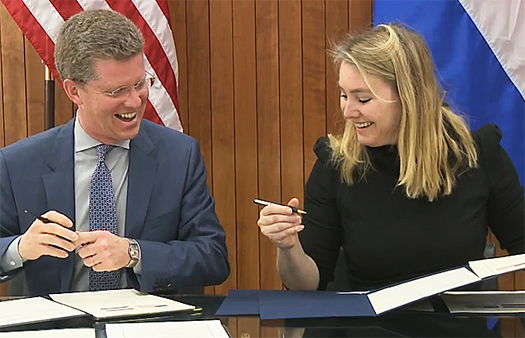Netherlands, US intensify cooperation on water management, climate resilience and flood preparedness
Dutch Minister Melanie Schultz van Haegen of Infrastructure and the Environment (right) and US secretary Shaun Donovan of Housing and Urban Development (left) signed an agreement pledging closer cooperation between their two countries on issues related to disaster mitigation, sustainable and integrated planning and water management infrastructure.
Donovan, who also chairs President Obama’s Hurricane Sandy Rebuilding Task Force, recently visited the Netherlands to see first-hand how that country deals with the persistent threat of North Sea and river flooding in large low-lying developed areas.
Age-old shared problems
"Our two nations have much to learn from each other about finding innovative solutions to age-old shared problems," said Donovan. "The Dutch are no strangers to the forces of nature and I’m certain we can benefit from their experience in disaster mitigation, infrastructure management and a variety of approaches to sustainable community development and planning."
Signing of the MoU by Melanie Schultz van Hagen and Shaun Donovan, followed by a short press meeting.
Vulnerable river deltas
"Although the scale of our landscapes differs, New York and the Netherlands have a lot in common," said Minister Schultz. “Both areas are river deltas. Both areas have estuaries, rivers and water basins that are vulnerable to flooding. The Netherlands has a long history in water management, but I am not coming only to bring Dutch expertise. I am also coming to learn from the American approach."
Risk redution strategies
Over the generations, Dutch planners created a vast network of dams, floodgates, storm surge barriers and other engineered works to control North Sea storm surge and flooding from the confluence of three major river systems. In recent years, Dutch engineers have also adopted hazard mitigation strategies that allow for controlled flooding in formerly developed areas.
Five years cooperation
The HUD-Dutch Memorandum of Understanding lays out certain areas of cooperation over the next five years including:
- creating new community development strategies that place a premium on sustainability and ‘livability’ principles;
- pursuing infrastructure and water management strategies and climate resilience and preparedness, including new approaches to flood protection systems and ‘building with nature;’ and
- leveraging private and philanthropic investments to maximize public investments in urban development and long-term disaster mitigation.
Both governments will prepare a concrete action plan.
Read the full text of the Memorandum of Understanding on the website of the Dutch Embassy in Washington
This news item was originally published on the website of the Royal Netherlands Embassy.
Previous Post-Sandy news items on this website:
● In-depth NY1 report on Dutch flood protection with an eye on post-Sandy New York, 28 February 2013
● First post-Sandy conference in New York on a long-term flood risk reduction strategy involved Dutch experts, 2 January 2013
● Adoption Dutch-based flood protection would require radical change US safety approach, 18 November 2012
● More new New Amsterdam: innovative flood protection for New York after superstorm Sandy, November 18, 2012
● NRP live radio debate: barricading New York against a rising sea, November 9, 2012
● Aftermath superstorm Sandy: How to reduce flood risk on US and Dutch barrier islands? - November 7, 2012
● Flood experts discuss need for storm surge barriers for coastal cities in aftermath of superstorm Sandy - November 2, 2012
● Dutch based flood protection plan for New York to revive in aftermath of superstorm Sandy - November 1, 2012
More information
Ministry of Environment and Infrastructure
The Hague, the Netherlands
+31 70 456 00 00
www.government.nl/ministries/ienm
U.S. Department of Housing and Urban Development
Washington, USA
+1 202 708 1112
www.hud.gov
Royal Netherlands Embassy
Washington, USA
+1 202-362-3430
ww.dc.the-netherlands.org




